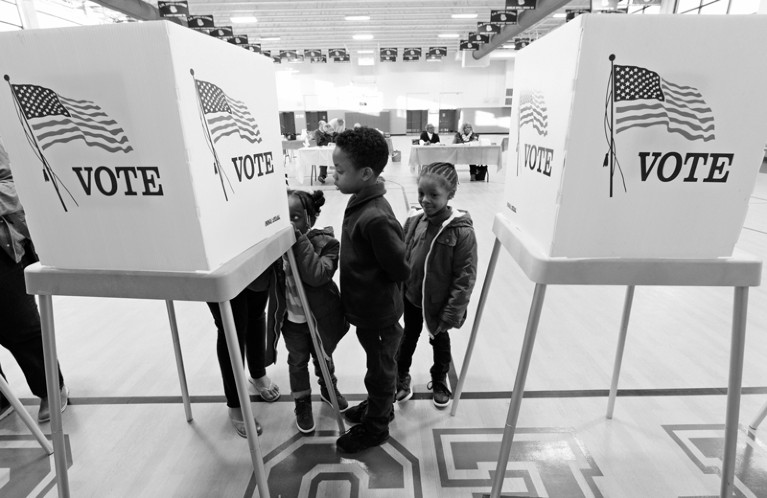
Mathematics has helped a US court to overrule an example of partisan gerrymandering in North Carolina.Credit: Jonathan Drake/REUTERS
Mathematicians are no longer devices for turning coffee into theorems, as the Hungarian mathematics researcher (and caffeine addict) Alfréd Rényi is said to have claimed. They seem pretty useful for preserving democracy, too. In striking down the way that officials in North Carolina unfairly partitioned the state into electoral districts, a US federal court last week conspicuously cited the work of mathematicians including Jonathan Mattingly, an expert in mathematical modelling.
In a 200-page decision released on 9 January, the three-judge court in Richmond, Virginia, said that the districting had unfairly favoured the Republican Party. Maths played a key part in helping the court to reach that decision, by demonstrating the unlawful use of partisan gerrymandering — fiddling with district boundaries to include or exclude certain voters and steer the results of an election. Those apportioning districts might draw borders that pack large numbers of voters for an opposition party into a small number of districts, for example, limiting the number of seats that the opposition can win. The process has been likened to allowing lawmakers to choose their voters, rather than the other way around.
Mattingly, a researcher at Duke University in Durham, North Carolina, used his expertise to argue that the state districts were drawn up to give Republicans an unfair advantage. To do so, he used an algorithm that produced around 24,000 maps of marginally different district configurations that were randomly drawn on the basis of geographic criteria. The Republican-drawn boundaries, which had delivered 9 Republicans to the state’s 13 seats in the House of Representatives in Washington DC in 2012, were more gerrymandered than practically every single one of Mattingly’s algorithm-derived maps. Using the same voting data, his maps nearly all gave a larger number of wins to the Democratic Party and, in many cases, gave it the majority.
Mattingly had taken an interest in the process after the 2012 elections and was called to testify after two advocacy organizations sued the state in federal court following the 2016 elections. In October, they asked Mattingly to take the stand and explain his work and its implications. He was ready: by then, he and his collaborators had done more-recent studies of the state’s current redistricting, engineered in 2016 by the Republican majority in the North Carolina General Assembly.
Some of the modelling is preliminary, but it has had a historic impact: last week’s ruling was the first time that a US federal court has struck down electoral districting for favouring one political party over another. (Previous rulings have done so for other reasons, such as racial disparities.) Gerrymandering is not exclusive to North Carolina, or to the US Republican Party. Courts have struck down pro-Democratic redistricting in Maryland, for example, and similar cases are being debated in the United Kingdom and elsewhere.
Last week’s ruling is not the final word on North Carolina’s system. The General Assembly has filed an appeal, and the case is likely to end up in the US Supreme Court. The court has ruled in the past that politically motivated gerrymandering was illegal, but also that there were no objective metrics to establish it.
But that is what Mattingly and others have been working to change — and the computer simulations could be needed more than ever. The upcoming 2020 US census will trigger widespread redrawing of electoral districts, and there are already concerns that gerrymandering will be rife.
Mattingly and other academics who study electoral systems are organizing to train their colleagues on the science of gerrymandering, and how to communicate it to a non-mathematical audience. One summer camp held last year had planned for 50 attendees; more than 1,000 applied. That’s a lot of coffee — and all of it consumed in a good cause.








